TOPOGRAPHICS
2 total works
This work explores the urban extremes of Europe in their cultural, physical, geographical and mythical dimensions. "Extreme Europe" considers the history and visual culture of Europe in the decade after the fall of the Berlin Wall. Barber sets out to explore and define Europe's political and conceptual edges, first making a circuit eastwards through Albania to Turkey, then south- and westwards along the Mediterranean coast, with stops in Crete and Marseilles. The book then moves through several decades of history as they can be read in both the surviving and rejuvenated fabrics of Berlin, and finally through the frayed, disaffected and multicultural landscapes of Paris' outer suburbs. The author's purpose in scanning Europe's geographical and psychological extremes is to examine its cities and their surrounding areas as sites of a conflict between the mesmerizing, all-engulfing power of the visual media and the tenacious, barely surviving traces of traditional culture. The book maintains that the "breakdown zones" at Europe's urban edges are the areas where its most oppositional and vital images and languages are being created today.
Exploring the visual transformation of the contemporary European city, especially Berlin, this book examines the visual process by which metropolitan identity is ricocheted back and forth between the surfaces of the city and its inhabitants. It analyzes the escalating fragmentation of the European city's implosions of culture, its historical voids, and its proliferations of violence. The author travelled extensively through the cities of Europe between 1990 and 1994 to witness their metamorphosis, and that of their inhabitants, following the end of the Cold War. His other books include "Antonin Artaud: Blows and Bombs".

